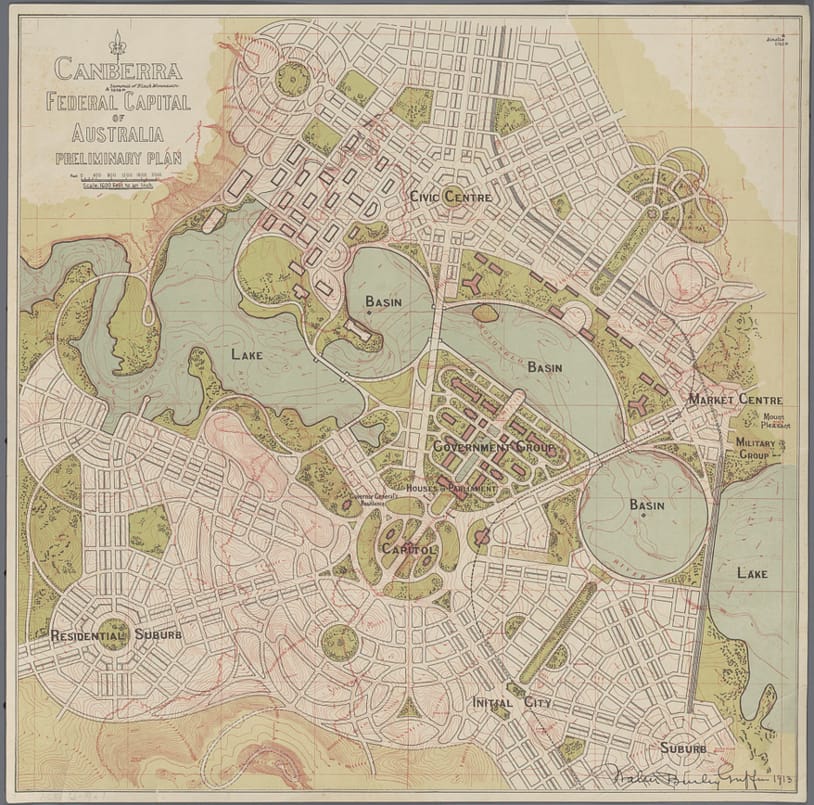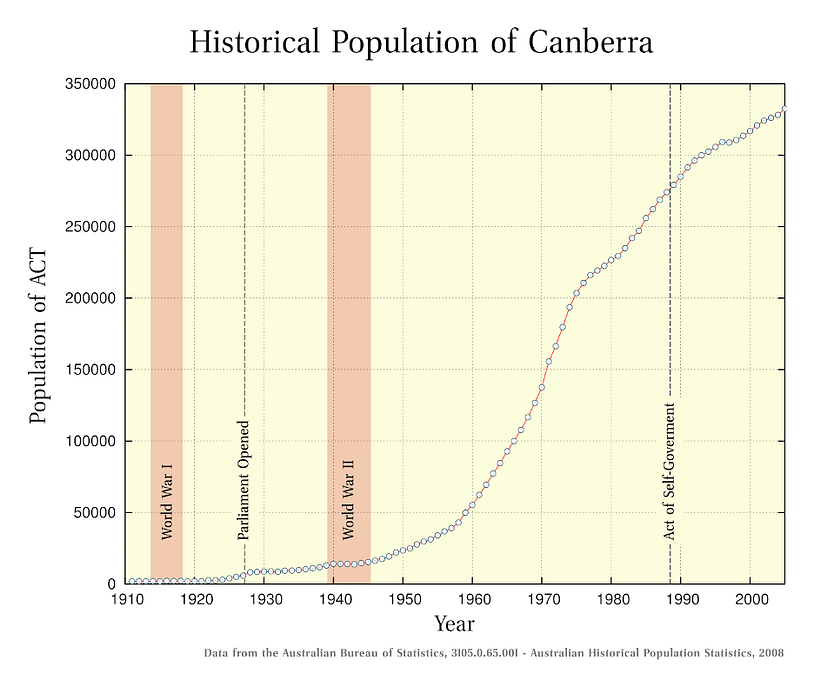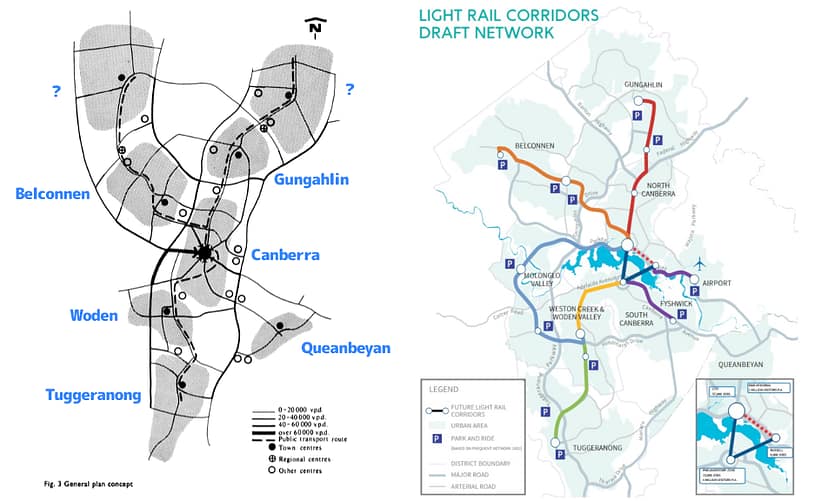The hundred year masterplan
I want to talk about planning in England from the perspective of someone who grew up in Canberra, a planned city. Since its inception in 1911, the details of the plan have changed, but, for more than a century, the broad vision has been followed and development of the Australian capital has been closely scrutinised. The result is a city that has been named the most liveable city in Australia, and indeed the world, rating as highly on quality of life as it does as a tourist destination.
Right now, here in England, new towns are in the news again, and the Planning for the Future white paper proposes Development Consent Orders for new communities as Nationally Significant Infrastructure - like water, energy, transport or communications. If, as the white paper suggests, the biggest problem facing the UK today is one of housing supply, then a planned city of half a million people seems a good case to study. What have planners of the Australian national capital got right? What have they got wrong?
In 1988 Sir Peter Hall referred to Canberra as “one of the last Cities Beautiful.” The reference is to the City Beautiful Movement which inspired the 1911 plan for a new Australian national capital by Walter Burley and Marion Mahony Griffin.
What “beautiful” meant to the Griffins differed from what it meant to many of their fellow Americans. The word “beautiful” was - and is, even in this country, to this day - often used to mean “monumental” and “classical”, which is why Washington DC is famous for the kind of architecture which, in turn, went on to inspire “McMansions” across the country.
Beauty, the Griffins understood, is to be found in an evidence-based design which responds to the needs of a public whose wellbeing is of the first importance. The Griffin plan for Canberra is dense but permeable, tight and efficient but with substantial green- and bluespace.

Griffin, Walter Burley and Australia. Department of Home Affairs. Canberra Federal Capital of Australia preliminary plan [Melbourne: Dept. of Home Affairs, 1914. Web. 27 September 2020

Canberra plan submitted to the Canberra design competition by Walter Burley Griffin "View from the summit of Mount Ainslie”. 1911-1912 Held at the National Archives of Australia
Designed for a city of “about 70,000 people” - similar to the “assumed optimum” for the British New Towns of the 40s - the plan was quite specific on a number of key factors, including:
neighbourhood units (explicitly named as such in 1911) and diversified urban sub-centres connected by a tramway system 'borne at public expense'; [...] The tramway would be paid out of revenue from the leasehold system, which was a central feature for the foundation of the capital. Public ownership of land in the form of leasehold would avoid speculation in undeveloped land; land value increases would remain in the public purse.
From the moment construction began in 1913, the Federal Government kept a close eye on its development, concerned above all that the national capital should generate a return on investment over the long run. Construction was slow during the World Wars and the Great Depression. In 1946, the Australian National University was established, but otherwise, during the 50s, development of the capital was restricted by a lack of resources in the area and a lack of executive power.
In 1958, the responsibility for Canberra’s development was vested in a single independent statutory body, called the National Capital Development Commission, which would, under the Menzies Government, see increased federal investment toward an administrative political centre fit for the departments of Government and, ultimately, for Parliament itself.
Almost immediately, something unanticipated happened:

Rupert Swarbrick. A graph of the population of the ACT over the 20th century. Wikimedia Commons 2009
It was clear, extrapolating the data, that a plan for a Canberra of half a million people would need to be developed as rapidly as possible. Consulting with planning experts in UK and USA, the NCDC made efforts to develop a plan for the growth of Canberra. However, despite the fact that the Griffin plan “included tram lines and even a suburban railway, [...] these vanished as, from the 1950s, the idea emerged that Canberra was to be made into a paradise for the motorist."
Specifically:
In 1965, [NCDC planner Peter] Harrison visited the United States, where he discussed the linear city concept with transport engineer Alan Voorhees. [...] Although [Gordon] Stevenson and Harrison proposed it as a way of diverting major roads away from Canberra’s centre, the linear city had actually been invented to promote rail transport.
The linear model that Voorhees proposed was based on similar models implemented in Copenhagen and Stockholm in the post-WWII period. In 1966, Vorhees was commissioned to develop a Land Use and Transport Study for a Canberra of 500,000 people. The resulting model, in 1967, was based on what was at the time a cutting-edge approach to transport modelling based on simulations (on paper) of movement under given conditions.
The study was criticised in 1969 for, among other things, lack of rigour “collecting and analysing the data usually used in a transportation study, relying instead on approximate measures of travel requirements derived from other cities.” Specifically, it used the results of an earlier survey, from 1961, which explicitly excluded non-owners of private vehicles:
Since the ACT had nearly 60,000 residents in 1961, but only 19,000 motor vehicles (ABS, 1963, pp. 286, 545), the majority of the population would have been excluded from the travel survey. Journeys made on foot or by bicycle were also excluded, even though these would have been significant, since many Canberrans still lived in hostels and other government housing close to workplaces. The second departure from US practice was the omission of the ‘mode split’ stage, in which the shares of travel by car and public transport are modelled.
As a result, the plan for the growth of Canberra came to rest on the premise of north-south expressways which would bypass the city centre and the Parliamentary Triangle, connecting “new towns” to the north and south. These “green corridors” would act as scaffolding for the future districts, now known as Belconnen, Woden, Tuggeranong and Gungahlin. Summarising the plan in 1967, William Holford (himself, at odds with the Commission, in favour of “electric fixed-rail traction”) explains that:
Within these parkways corridors and the 'urban corridors', which are to run through the districts themselves, there will be room not only for the regional highway, but for reserved lanes for public transport vehicles, tracked or trackless.
Compare the “Y form” plan proposed by the NCDC in 1967 (present day district names added for context) to the recent plan for a new light rail network in Canberra, the first line of which opened only in 2019:

Left: Holford, William, "Tomorrow's Canberra: A Review Article", TPY, 43 (1) July 1972 pp26-30Right: Transport for ACT, from Probert, Oliver (2015) “Canberra outlines plan for light rail city” <https://www.railexpress.com.au/canberra-outlines-plan-for-light-rail-city/>
It inclines one immediately to wonder: if the plan for light rail was there in the 60s (and, indeed, in the original Griffin plan), why is it only being built now, half a century later?
Economic self-containment: size matters
The “moral for Canberra,” as Holford aptly summarises, was based on “borrowing from a future when there will be a nation of 20 millions and a city of half-a-million.” As it happens:
...the Griffin plan was based on a concept of continuous growth beyond the range of 25,000 to 75,000 stipulated in the competition conditions. But the 1950s and 1960s were the era of the British New Towns;
In 1961, the Chairman of the Hemel Hempstead New Town Corporation, Henry Wells, was approached for advice on the financials of the capital as a capital investment. Australia took a lead from England’s “Garden City” movement. One of the defining ideals of the Garden City was a road system “planned for safety as well as freedom of movement” and, specifically, in the 60s, the concept of “community without propinquity” - in other words, “low-density motorised living”. Of course, as we know now, “the goal of self-containment was never achieved in the postwar new towns,” with one exception:
Milton Keynes[, ] with over 80% percent [sic] of workers finding employment in the borough during the first decade of this century [...] stands in stark contrast, however, to the lacklustre economic performance and town centres of much smaller new towns[...] It appears that size matters.
Given a choice between steady infill as per the Griffin plan on the one hand, and suburban sprawl on the other, the planners of Canberra “opted for a predominantly low density growth form”. In other words, the data was fudged for ideological reasons. The NCDC were wedded to the same mythical ideal that ultimately led to poor health outcomes and, indeed, economic failures of the New Towns in England.
The situation changed in 1972, when Gough Whitlam became the first Labor Prime Minister since 1949. Whitlam, having himself grown up in Canberra, was keenly interested in the power of political will in planning the national capital. With his Minister for Urban and Regional Development, Tom Uren, Whitlam acted swiftly to rectify the mistakes of the NCDC.
The first step was to commission the Canberra Short Term Transport Planning Study, which “employed new modelling techniques, based on ‘the simulation of individual traveller behaviour’”. As Holford summarises in 1972:
What was done by heart and is now being done by the head. Political faction and fantasies of design have succeeded by social and economic analysis and the aid of computers.
The study demonstrated that car dependency was not a forgone conclusion, even with the low-density plan for Canberra already being implemented, the first residents having moved into Woden, Weston Creek and Belconnen in the late 60s.
Uren having articulated a transport policy which would subsidise public transport subsidy over new roads, the NCDC warned that it would lead to congestion. The Government’s response, in 1974, suggested that congestion would act as a disincentive for private car ownership, provided there was a viable alternative in the form of buses. Sure enough:
The share of ACT households without cars actually increased, from 6.5 to 8.4 per cent, between 1976 and 1981, while car ownership rates stagnated: by 1980 the ACT had lower car ownership rates than any of the states. [...] Canberrans had confirmed what the modelling of the Short Term Transport Study had predicted.
As anyone who’s used it knows, ACTION - the bus system in Canberra - is among the worst in the world today. How can this be? What happened?
A perpetual battle against an empire
In 1975, the Third Whitlam Ministry faced a crisis of supply in the Australian Senate. In fact, Whitlam’s approach to taking control of the Senate included the introduction of two Senate seats for the Australian Capital Territory. Susan Ryan - who, sadly, passed away 27 September this year - became the first Labor Senator for Canberra in December of that year - too late to save Whitlam, who was dismissed by the Governor General on Remembrance Day.
The NCDC worked quickly to suppress the findings of the Short Term Transport Study, asserting in 1978 that the 1974 transport policy, which was based on the study, was “not used as a measure to achieve greater use of public transport.” Over the course of the early 80s, the NCDC built a narrative - based, as in the 60s, on fudged data - of ACTION as a drain on the public purse. With the rise of Economic Rationalism in the late 80s, ACTION soon faced massive cuts, leaving Canberra with the bus system it has now.
Not all was lost, however. In 1991, the Sustainable Canberra report assessed transport and land use data for the national capital in comparison with other cities across the globe. The report’s recommendations? Greater density, light rail. The ideas that had underpinned the Griffin plan grew popular again. Usefully, as we will recall, the Voorhees Y Plan was, in fact, originally designed for light rail.
The ACT has, just now, reelected the Labor party for the Legislative Assembly. On Monday 1 November, they formed Government in a coalition with the Greens, who tripled their seats. Both parties ran on light rail, as opposed to the more car-friendly Liberals.
This election is, in other words, only the latest stage in what Marion Mahoney Griffin called “a perpetual battle, one might say against an Empire.” The “battle of Canberra” has raged for a century, a batte between two sides - on one side, evidence; on the other, ideology - both sides vying for the meaning of the word “beauty”.
Why should we care?
In January this year, Ordnance Survey announced Colouring London, a project to crowdsource data on London’s building stock, explaining that, “without a building dataset,” we, as a society, are not “able to create accurate theoretical planning and energy scenarios [...] critical to creating a sustainable city.” The project is part of a broader Colouring Cities research programme based on an “open data/open code approach” designed “to stimulate a rapid increase in the volume, detail, variety and quality of open spatial data available for cities, at building scale, in a way that [...] widens public participation [and] promotes citizen science.”
Of all the examples in my opening paragraph, Ordnance Survey is the only one that doesn’t lean on the public for its data. OSM and Wikipedia are crowdsourced. Much of Fingertips data is self-reported. Why are Ordnance Survey going to the public now? Because their high-level approach, based almost entirely on remote sensing - while very useful for “areas which are difficult to access” - is useless when it comes to the built environment.
The mistake the NCDC made, modelling the growth of Canberra, was excluding large swathes of the public from their survey. If, as we’ve seen, this was unforgivable in the 60s, it is only more so in the 21st century.
In July this year, Transport for New Homes published a study of new and proposed garden communities from a transport-oriented design perspective. Of the twenty “core” communities, not one had secured funding for a national rail link. In fact, the only funding they found allocated to rail was at Beaulieu, in Chelmsford - “the first railway station to be built on the Great Eastern main line for over 100 years” - sourced from the Housing Infrastructure Fund.
Clearly, despite the high-minded ideals behind the new developments involved, a fundamental mistake is being made. Transport for New Homes argues the mistake is being made at a national policy level, specifically in the allocation of housing targets based on a model that excludes transport. It looks to me like national planning policy makes the same mistake the NCDC made, and for the same reason: the fantasy of the English countryside relies on cars.
The Building Better Building Beautiful commission report, Living with Beauty, takes pains to include transport - among many other things - under “beauty” as an umbrella term:
There is little doubt that the location of new development has a considerable impact on whether a beautiful outcome can be achieved. Transport, utility and social infrastructure are fundamental components of placemaking.
It’s therefore strange that the white paper makes almost no reference to transport, and, indeed, no reference to rail at all. Only one reference is made to cars (in an answer to question 16).
A search for “public transport” turns up a single result:
in identifying land for inclusion within the Growth area, or the densities of development appropriate in different locations, the ability to maximise walking, cycling and public transport opportunities will be an important consideration.
This vague statement is followed by proposal 16: “a quicker, simpler framework for assessing environmental impacts” - in other words, a framework based on less - not more - data.
The Living with Beauty report also emphasises:
...that the planning process must be both open to the broadest possible public involvement, as well as being able to represent the public interest even when local engagement is hesitant or absent.
It’s therefore strange that the white paper’s proposals extend Permitted Development Rights under the so-called “fast track for beauty.” The word “beauty” here refers to designs that are “popular and attractive”, a beauty that is skin deep. This is not the beauty of the Griffin plan, the evidence-based beauty that responds to the needs of the public.
It’s telling that the white paper, ostensibly all about a planning system based on data, should undervalue data collection. The white paper should champion masterplan data, but masterplan data is meaningless without contextual data, and a masterplan is meaningless without evidence.
In the vision of the Web originally propounded by Sir Tim Berners-Lee, the Internet would become the vehicle for the massive democratisation of civic decision making. This vision has to a great extent transpired: in the 21st century, we live in a world driven by data, and while a lot of that data is held by firms, a lot more of it is publicly available - and, increasingly, publicly collected.
The reality of a data-driven world is that the public and data are inseparable. The poor planning decisions that undermine environmental sustainability and public health and wellbeing will always be made by those who fudge the data. We, as a nation, have the chance, now, to build a planning system that is driven by data in the sense in which Berners-Lee meant the word: a planning system that represents the public.
